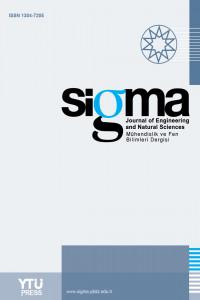Abstract
Determination of the optimum trip schedules is an important problem for public transportation systems. It is complex task to assign optimum number of vehicles and determine the trip schedules for a public transport systems which consist of many routes. In the case of taking infrequent trip schedules, the existing passenger demand is not satisfied. Therefore waiting times are increased in the bus stops. In contrary, with more frequent intervals, unutilized capacity and higher operational costs are expected. Also, intense traffic density and environmental pollution are associated with the frequent trips. The optimum trip frequencies of the passenger demands varies during the hours of a day and is important for passenger satisfaction and operation efficiency of the system. Trip scheduling and vehicle assignment studies take attention in the current literature assisted with different optimization techniques and artificial intelligence method. In this study, only 10 different bus routes which is operated privately, were considered in the city center of Antalya and the Linear Goal Programming (LGP) was used to determine the optimum number of vehicles operated on the routes. The study results showed that the existing system performance can be preserved by reducing the frequency of specific trips and LGP is stated as an efficient algorithm for determining the optimum trip frequencies and number of vehicles in a public transportation systems.
References
- [1] Dantzig G.B., (1948) Programming in a Linear Structure. Comptroller, United States Air Force, Washington DC.
- [2] Charnes A. and Cooper, W.W., (1961) Management Models and the Industrial Applications of Linear Programming. John Wiley, New York
- [3] Lee S.M., (1972) Goal Programming for Decision Analysis. Auerbach, Philadelphia.
- [4] Ignizio J.P., (1976) Goal Programming and Extensions. D. C. Heath and Company, Lexington
- [5] Romero C., (1982) On Misconceptions in Goal Programming. The Journal of the Operational Research Society, 42, 927-928.
- [6] Schniederjans M.J., (1984) Linear Goal Programming. Petrocelli, Princeton.
- [7] Tamiz M. and Jones D.F., (1996) Goal Programming and Pareto Efficiency. Journal of Information and Optimization Sciences, 17, 291-307. http://dx.doi.org/10.1080/02522667.1996.10699283.
- [8] Orumie, U. C. and Ebong, D., (2014) A Glorious Literature on Linear Goal Programming Algorithms. American Journal of Operations Research, 2014.
- [9] Dağdeviren, M. Akar, D. and Kurt, M. (2004). “İş Değerlendirme, Faktör Derece Puanlarının Belirlenmesinde Hedef Programlama Yönteminin Kullanılması”, Gazi Üniversitesi Mühendislik Fakültesi Dergisi, 19(1), 91.
- [10] Alp S., (2008) Doğrusal Hedef Programlama Yönteminin Otobüsle Kent İçi Toplu Taşıma Sisteminde Kullanılması. İstanbul Ticaret Üniversitesi Fen Bilimleri Dergisi, 1: 13 s. 73-91.
- [11] Ignizio J., (1985) Introduction to Goal Programming, Sage Publications Inc., USA.
- [12] Rardin R. L., (1998) Optimization in Operations Research (Vol. 166). Upper Saddle River, NJ: Prentice Hall
- [13] Hillier F. S. and Lieberman, G. J., (1990) Introduction to Stochastic Models in Operations Research. McGraw-Hill Companies.
- [14] Sharma N. K. and Bhatia, O. S. (2016). Application of Linear Goal Programming (LGP) To Case Study Provider Quota Distribution. Journal of Mechanical and Civil Engineering (IOSR-JMCE). 13(2), 38-40.
- [15] Bassey, U.N. and Effanga, E.O. (2008). A Linear Goal Programming Model for the Linear Absolute Value Regression Problem. Journal of Modern Mathematics and Statistics 2(3): 123-125.
- [16] Ahern, A and Anandarajah, G. (2006). “Railway Projects Prioritisation for Investment: Application on Goal Programming”, Transport Policy, 14(1), 70-80.
- [17] Shivastava, P. (2007). “Design of Feeder Route Network Using Combined Genetic Algorithm and Specialized Repair Heuristic”, Journal of Public Transportation, 10(2), 109-133.
- [18] Leung Stephen, C.H., Wu, Y and Lai, K.K. (2006). “Cross-Border Logistics with Fleet Management: A Goal Programming Approach”, Computers & Industrial Engineering, 50(1), 263-272.
- [19] Abd El-Wahed, Waiel F. and Sang M. L. (2006). “Interactive Fuzzy Goal Programming for Multi-Objective Transportation Problems”, The International Journal of Management Science (Omega), 34(2), 158-166.
- [20] Braysy, Olli AND Gendreau, (2005). “Vehicle Routing with Time Windows, Part I: Route Construction and Local Search Algorithms”, Transport Science, 39(1), 104-118.
- [21] Tekin, S., Köfteci, S. and Aydın, M. M. (2017). Schedule Optimization of Public Transportation System by Using Linear Goal Programming Method. Conference of the International Journal of Arts & Sciences. 10(02), 183-184.
- [22] Deri A., (2012) Akıllı Kart Verileri Kullanılarak Toplu Ulaşım Yolculuk Talebinin Belirlenmesi Ve Sefer Çizelgeleme Optimizasyonu. Yüksek Lisans Tezi, Dokuz Eylül Üniversitesi Fen Bilimleri Enstitüsü, İzmir.
- [23] Uludağ, N., (2010) Bulanık Optimizasyon Ve Doğrusal Hedef Programlama Yaklaşımları İle Otobüs Hatlarının Modellenmesi. Doktora Tezi, Pamukkale Üniversitesi Fen Bilimleri Enstitüsü, Denizli.
- [24] Aydin M.M., Yıldırım M.S., Aydin R., Arslan Y., (2016). "Effect of different passenger characteristics and bus types on boarding times at bus-stops", Journal of Engineering Research and Applied Science, 5(2), 499-599.
- [25] BMC, (2018). http://www.bmc.com.tr/wp-content/uploads/2015/01/BMC-ProCity.pdf
- [26] Sevim İ., Tekiner Moğulkoç H., Güler M. G., Mutlu Z. P., (2016). “Automated Vehicle Scheduling System: A Case Study of Metrobus System”, Sigma J Eng & Nat Sci, 7(1), 1-7.
Details
| Primary Language | English |
|---|---|
| Journal Section | Research Articles |
| Authors | |
| Publication Date | December 1, 2018 |
| Submission Date | September 22, 2017 |
| Published in Issue | Year 2018 Volume: 36 Issue: 4 |
IMPORTANT NOTE: JOURNAL SUBMISSION LINK https://eds.yildiz.edu.tr/sigma/


